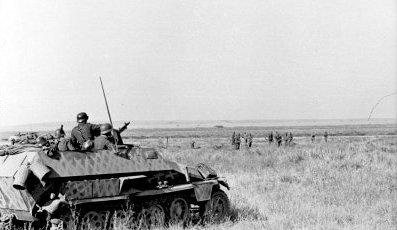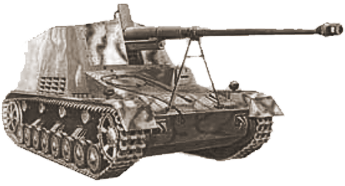Sixth Army's Flanks Outside Stalingrad: The Beginning

In recent weeks I have been examining the Soviet offensives launched against the German Sixth Army's flanks as it pounded it's way into Stalingrad. However, there is one important point that needs to be stressed. The First Kotluban offensive of September 1942 was far from the first Soviet effort to throw back Sixth Army from Stalingrad. In fact, from the very first day that Sixth Army's spearheads reached the Volga River they were under near continuous attack.
On August 23, 1942 Sixth Army's XIV Panzer Corps exploded from its bridgehead over the Don River. The 16th Panzer Division led the way with XIV Panzer Corps other formations, 3rd and 60th Motorized Divisions, trailing behind. Late in the day 16th Panzer Division's leading elements reached the Volga River near Rynok just north of Stalingrad, splitting the Soviet Stalingrad Front from the Southeastern Front and cutting most key communications networks between the Caucuses and the remainder of the Soviet Union. The 16th Panzer Division and the two motorized divisions strung out to the west all formed hedgehog defensive positions for the night while Stakva scrambled to respond. And respond they did, as did Stalingrad Front's commander.
Eremenko assembled a motley group of units that nevertheless in the agregate were able to form a defensive perimeter in Stalingrad's northern suburbs at the same time reserves gathered to strike the northern flanks of XIV Panzer Corp's corridor to the Volga. By August 24th the defenders of Stalingrad included:
- A Battalion of Naval Infantry
- Two Battalions of student officers
- Militia comprised of factory workers from the huge Tractor, Red October, and Barrikady Factories within Stalingrad (including 60 tanks manned by factory workers)
- Offshore artillery support from the Volga River Flotilla
- The 10th NKVD Rifle Division
- The 99th Tank Brigade
- 21st and 28th Tank Battalions
- An anti-tank artillery regiment (from 57th Army)
- Three more anti-tank artillery regiments (from personnel assembled from the same school that had formed the battalions of student officers)
- One artillery battalion
- The 115th, 124th, and 149th Rifle Brigades (scheduled to arrive in Stalingrad on August 27th)
- All available anti-aircract guns (totalling some 560 weapons)
- 2nd Tank Corps (both inside and outside the German corridor having been split by the sudden German advance)
Eremenko's fast reaction proved enough to stymie the German advance and allow the reeling 62nd Army to fall back into the city. However, by itself these actions would have been fruitless against the combined power of the XIV Panzer Corps. Most of the credit for crippling the XIV Panzer Corps advance into the city has to go to the Stalingrad Front's units putting heavy pressure on both the northern and southern shoulders of the German defensive corridor. Efforts bolstered by Stavka's decision to dispatch the 4th and 16th Tank Corps and 24th, 64th, 116th, 173rd, 221st, and 308th Rifle Divisions to the Stalingrad Front as well as the new 66th Army (with eight more rifle divisions). However, it would take time for these resesrves to reach Eremenko.
Thus the initial efforts outside the corridor were led by the Soviet 2nd, 23rd, and 28th Tank Corps, 169th Tank Brigade, 27th and 35th Guards Divisions, and 87th and 298th Rifle Division. Between August 23rd and 29th these Soviet units pounded away at XIV Panzer Corps, while many of the units listed above attacked from their positions within Stalingrad's suburbs. Though failing to destroy the German corridor to the Volga, at several times they had XIV Panzer Corps on the ropes with the corridor at times reduced to a mere four kilometers in width. Meanwhile, and to the west, the Soviet 4th Tank and 62nd Army attempted to cut off XIV Panzer Corps but the 76th, 295th and 384th Infantry Divisions of Sixth Army's VIII and LI Army Corps stopped them cold. By August 28th the Soviet 4th and 16th Tank Corps could deploy a mere two dozen operational tanks each and many of Eremenko's other units had been equally mauled.
The reasons for the Soviet inability to dislodge or destroy XIV Panzer Corps are many and include poor command and control, piecemeal rather than concentrated attacks (keep in mind that Stalingrad Front hurled some 350 tanks against the XIV Panzer Corps and the supporting German infantry divisions in the last week of August - had the efforts of this huge armored armada been concentrated it is doubtful whether XIV Panzer Corps could have held its positions), not enough time taken to prepare assaults, lack of air support, and threadbare logistics. In addition, the Germans were well dug in with plenty of armored fighting vehicles in their own right (see picture of German half-track on steppe) and ample air support from VIII Air Corps. Nevertheless, the combined impact of the Soviet attacks against XIV Panzer Corps from both within and outside the corridor proved pivotal in preventing the Germans from driving into the then highly vulnerable factory district just south of Stalingrad's notherrn suburbs.
One must remember that on the evening of August 23rd the lead kampfgruppe from the 16th Panzer Division (comprised of tanks and panzer-grenadiers) stood on the banks of the Volga with only the weakest enemy force guarding Stalingrad proper. However, in addition to the gathering Soviet forces on its flanks the XIV Panzer Corps as a whole also battled against critical shortages in ammunition and fuel. By the time the 3rd Motorized Division fought it's way east and was able to replenish 16th Panzer Division it was too late. The Soviet counterattacks had battered the German spearhead for nearly an entire week forcing 16th Panzer Division to withdraw two kilometers from Rynok on August 31st. That had ended the German Sixth Army's opportunity to take Stalingrad before 62nd Army fell back into the city and before substantial Soviet reinforcements flooded into the region.
This is so very important to remember because at the exact same moment in time the Axis powers were expending enormous resources maintaining a powerful armored grouping deep in Egpyt at a time when Rommel's drive east had already long since passed its culmination point and was accomplishing next to nothing. Had even one or two of the panzer and infantry divisions wallowing in the Egpytian desert been transferred to Southern Russia early in August (when Rommel's best chance to finish off the British Commonwealth forces in Egpyt had been defeated) one can only imagine the impact of what such a seemingly small force would have had on the crucial battlefields outside Stalingrad late in August given what just a single panzer and two motorized divisions had already accomplished in racing from the Don to the Volga Rivers in a single day.



Post new comment